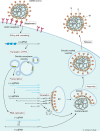Harnessing the immune system to overcome cytokine storm and reduce viral load in COVID-19: a review of the phases of illness and therapeutic agents
- PMID: 33059711
- PMCID: PMC7558250
- DOI: 10.1186/s12985-020-01415-w
Harnessing the immune system to overcome cytokine storm and reduce viral load in COVID-19: a review of the phases of illness and therapeutic agents
Abstract
Background: Coronavirus disease 2019 (COVID-19) is caused by Severe Acute Respiratory Syndrome Coronavirus 2 (SARS-CoV-2, previously named 2019-nCov), a novel coronavirus that emerged in China in December 2019 and was declared a global pandemic by World Health Organization by March 11th, 2020. Severe manifestations of COVID-19 are caused by a combination of direct tissue injury by viral replication and associated cytokine storm resulting in progressive organ damage.
Discussion: We reviewed published literature between January 1st, 2000 and June 30th, 2020, excluding articles focusing on pediatric or obstetric population, with a focus on virus-host interactions and immunological mechanisms responsible for virus associated cytokine release syndrome (CRS). COVID-19 illness encompasses three main phases. In phase 1, SARS-CoV-2 binds with angiotensin converting enzyme (ACE)2 receptor on alveolar macrophages and epithelial cells, triggering toll like receptor (TLR) mediated nuclear factor kappa-light-chain-enhancer of activated B cells (NF-ƙB) signaling. It effectively blunts an early (IFN) response allowing unchecked viral replication. Phase 2 is characterized by hypoxia and innate immunity mediated pneumocyte damage as well as capillary leak. Some patients further progress to phase 3 characterized by cytokine storm with worsening respiratory symptoms, persistent fever, and hemodynamic instability. Important cytokines involved in this phase are interleukin (IL)-6, IL-1β, and tumor necrosis factor (TNF)-α. This is typically followed by a recovery phase with production of antibodies against the virus. We summarize published data regarding virus-host interactions, key immunological mechanisms responsible for virus-associated CRS, and potential opportunities for therapeutic interventions.
Conclusion: Evidence regarding SARS-CoV-2 epidemiology and pathogenesis is rapidly evolving. A better understanding of the pathophysiology and immune system dysregulation associated with CRS and acute respiratory distress syndrome in severe COVID-19 is imperative to identify novel drug targets and other therapeutic interventions.
Keywords: Acute respiratory distress syndrome; Angiotensin converting enzyme 2; Antiviral; COVID-19; Chloroquine; Cytokine release syndrome; Immunotherapy; Pathophysiology; SARS-CoV-2; Tocilizumab.
Conflict of interest statement
All authors have declared they have no competing interests.
Figures



References
-
- John Hopkins Coronavirus Dashboard [Web]. Website2020. https://coronavirus.jhu.edu/map.html.
-
- organization Wh. Coronavirus disease 2019 (COVID-19) Situation Report-60.
-
- Schiffmann A. COVID 19 Live Dashboard. In: Schiffmann A, editor. 2019.
Publication types
MeSH terms
Substances
LinkOut - more resources
Full Text Sources
Miscellaneous

